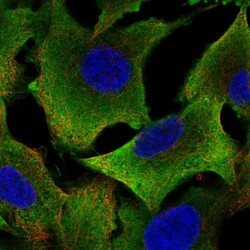Antibody data
- Antibody Data
- Antigen structure
- References [9]
- Comments [0]
- Validations
- Immunocytochemistry [1]
Submit
Validation data
Reference
Comment
Report error
- Product number
- HPA002123 - Provider product page

- Provider
- Atlas Antibodies
- Proper citation
- Atlas Antibodies Cat#HPA002123, RRID:AB_1844722
- Product name
- Anti-ALDH1A1
- Antibody type
- Polyclonal
- Description
- Polyclonal Antibody against Human ALDH1A1, Gene description: aldehyde dehydrogenase 1 family, member A1, Alternative Gene Names: ALDH1, PUMB1, RALDH1, Validated applications: ICC, IHC, WB, Uniprot ID: P00352, Storage: Store at +4°C for short term storage. Long time storage is recommended at -20°C.
- Reactivity
- Human
- Host
- Rabbit
- Conjugate
- Unconjugated
- Isotype
- IgG
- Vial size
- 100 µl
- Concentration
- 0.1 mg/ml
- Storage
- Store at +4°C for short term storage. Long time storage is recommended at -20°C.
- Handling
- The antibody solution should be gently mixed before use.
Submitted references Distributional coding of associative learning in discrete populations of midbrain dopamine neurons
Targeting ITGB4/SOX2-driven lung cancer stem cells using proteasome inhibitors
Preventive Vitamin A Supplementation Improves Striatal Function in 6-Hydroxydopamine Hemiparkinsonian Rats
Mechanism of lung development in the aetiology of adult congenital pulmonary airway malformations
STAT3 inhibition with galiellalactone effectively targets the prostate cancer stem-like cell population
SREBP-2 promotes stem cell-like properties and metastasis by transcriptional activation of c-Myc in prostate cancer
Pluripotency markers are differentially induced by MEK inhibition in thyroid and melanoma BRAFV600E cell lines
Identification of Active Retinaldehyde Dehydrogenase Isoforms in the Postnatal Human Eye
The CD44+ALDH+ Population of Human Keratinocytes Is Enriched for Epidermal Stem Cells with Long-Term Repopulating Ability
Avvisati R, Kaufmann A, Young C, Portlock G, Cancemi S, Costa R, Magill P, Dodson P
Cell Reports 2024;43(4):114080
Cell Reports 2024;43(4):114080
Targeting ITGB4/SOX2-driven lung cancer stem cells using proteasome inhibitors
Guo L, Mohanty A, Singhal S, Srivastava S, Nam A, Warden C, Ramisetty S, Yuan Y, Cho H, Wu X, Li A, Vohra M, Saladi S, Wheeler D, Arvanitis L, Massarelli E, Kulkarni P, Zeng Y, Salgia R
iScience 2023;26(8):107302
iScience 2023;26(8):107302
Preventive Vitamin A Supplementation Improves Striatal Function in 6-Hydroxydopamine Hemiparkinsonian Rats
Marie A, Leroy J, Darricau M, Alfos S, De Smedt-Peyrusse V, Richard E, Vancassel S, Bosch-Bouju C
Frontiers in Nutrition 2022;9
Frontiers in Nutrition 2022;9
Mechanism of lung development in the aetiology of adult congenital pulmonary airway malformations
Taylor B, Rice A, Nicholson A, Hind M, Dean C
Thorax 2020;75(11):1001-1003
Thorax 2020;75(11):1001-1003
STAT3 inhibition with galiellalactone effectively targets the prostate cancer stem-like cell population
Canesin G, Maggio V, Palominos M, Stiehm A, Contreras H, Castellón E, Morote J, Paciucci R, Maitland N, Bjartell A, Hellsten R
Scientific Reports 2020;10(1)
Scientific Reports 2020;10(1)
SREBP-2 promotes stem cell-like properties and metastasis by transcriptional activation of c-Myc in prostate cancer
Li X, Wu J, Li Q, Shigemura K, Chung L, Huang W
Oncotarget 2016;7(11):12869-12884
Oncotarget 2016;7(11):12869-12884
Pluripotency markers are differentially induced by MEK inhibition in thyroid and melanoma BRAFV600E cell lines
Dorris E, Blackshields G, Sommerville G, Alhashemi M, Dias A, McEneaney V, Smyth P, O'Leary J, Sheils O
Cancer Biology & Therapy 2016;17(5):526-542
Cancer Biology & Therapy 2016;17(5):526-542
Identification of Active Retinaldehyde Dehydrogenase Isoforms in the Postnatal Human Eye
Lewin A, Harper A, Wiechmann A, Moiseyev G, Ma J, Summers J
PLOS ONE 2015;10(3):e0122008
PLOS ONE 2015;10(3):e0122008
The CD44+ALDH+ Population of Human Keratinocytes Is Enriched for Epidermal Stem Cells with Long-Term Repopulating Ability
Szabo A, Fong S, Yue L, Zhang K, Strachan L, Scalapino K, Mancianti M, Ghadially R
Stem Cells 2013;31(4):786-799
Stem Cells 2013;31(4):786-799
No comments: Submit comment
Supportive validation
- Submitted by
- Atlas Antibodies (provider)
- Main image

- Experimental details
- Immunofluorescent staining of human cell line A549 shows localization to cytosol.
- Sample type
- Human
 Explore
Explore Validate
Validate Learn
Learn Western blot
Western blot Immunocytochemistry
Immunocytochemistry